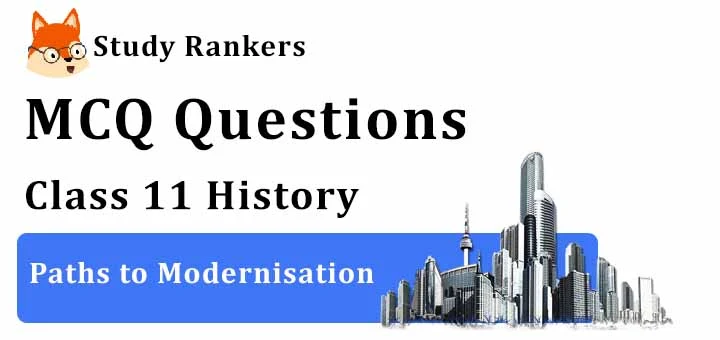MCQ Questions for Class 11 History: Ch 11 Paths to Modernisation

1. The Western sciences such as astronomy and mathematics were introduced in China by
(a) Biblical missionary
(b) Jehovah missionary
(c) Jesuit missionaries
(d) Prophet missionary
► (c) Jesuit missionaries
2. Syngman Rhee, Korea’s first elected president had to resign, after the April Revolution because:
(a) Rhee got himself elected as president, in 1948 CE, through illegal means.
(b) Rhee extended his rule by illegally amending constitution.
(c) Koreans protested against a rigged election, which took place in 1960 CE.
(d) Koreans desired unification of North and South Korea, which Rhee was unwilling to accommodate.
► (c) Koreans protested against a rigged election, which took place in 1960 CE.
3. Japanese rule in Korea, which lasted till 1945 CE, was not liked by Koreans because:
(a) Koreans preferred being ruled by China, instead of Japan.
(b) Japan, a puppet of Western powers, ruled as per the latter’s desires.
(c) Japan wanted to suppress Korean culture and forcibly assimilate Koreans.
(d) Koreans wanted restoration of Joseon rule in Korea.
► (c) Japan wanted to suppress Korean culture and forcibly assimilate Koreans.
4. The third longest river in the world that flows in China is the
(a) Pearl River
(b) Xi River
(c) Yangtse River (Chang Jiang)
(d) Yellow River (Huang He)
► (c) Yangtse River (Chang Jiang)
5. Mao Tse Tung advocated ways of solving social problems based on a survey conducted in 1930 in
(a) Fuzhou
(b) Jiujiang
(c) Nanchang
(d) Xunwu
► (d) Xunwu
► (d) Xunwu
6. The Korean president, whose resignation was demanded by citizens, through candlelight protests, was:
(a) Park Chung-hee
(b) Park Geun-hye
(c) Chun Doo-hwan
(d) Roh Tae-woo
► (b) Park Geun-hye
7. After the Korean War, South Korea received economic assistance from:
(a) U.S.A.
(b) U.N.O.
(c) China
(d) Japan
► (a) U.S.A.
8. Japanese borrowed their written script from
(a) China
(b) Russia
(c) Korea
(d) Taiwan
► (a) China
9. The independence of Korea, after World War II, was ensured due to:
(a) Japan’s defeat and surrender in World War II
(b) Continued efforts of freedom activists within and outside Korea
(c) Support of international leaders for Korea’s independence
(d) Temporary division of Korean peninsula
► (b) Continued efforts of freedom activists within and outside Korea
10. An immediate result of the Commodore Matthew Perry's visit to Japan in 1853 was _________.
(a) an alliance between Japan and USA
(b) development of trade between Japan and the West
(c) a war between Japan and USA
(d) the increased isolation of Japan
► (b) development of trade between Japan and the West
11. Japan imported luxury goods from ______.
(a) China
(b) Russia
(c) Korea
(d) India
► (a) China
12. Silk industry was developed in ______ so as to reduce import of silk.
(a) Osaka
(b) Kyushu
(c) Nishijin
(d) Beppu
► (c) Nishijin
13. In 1867-68 CE, ______ rule in Japan ended.
(a) The Shogun
(b) The Meiji
(c) The Nishijin
(d) None of the above
► (a) The Shogun
14. The slogan ‘Fukoku Kyohei’ under the Meiji rule in Japan meant _______.
(a) rich country, strong army
(b) strong lands, strong rivers
(c) rich lands, strong rivers
(d) rich country, weak neighbour
► (a) rich country, strong army
